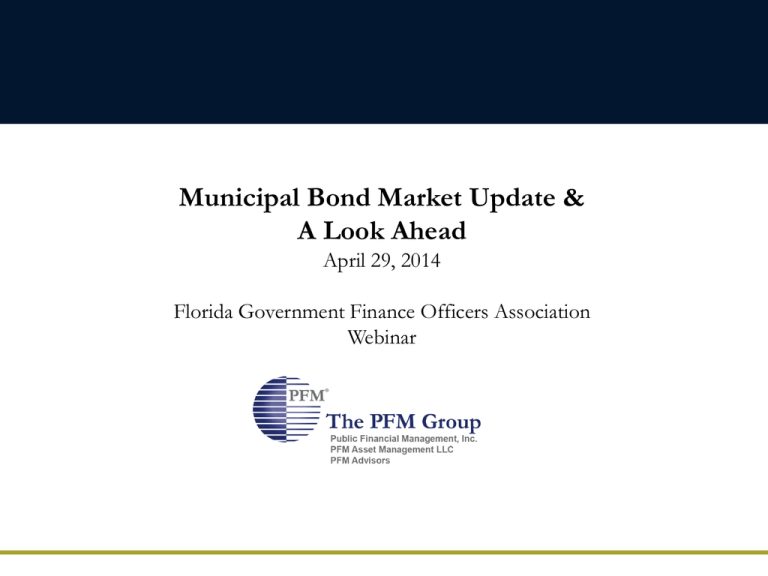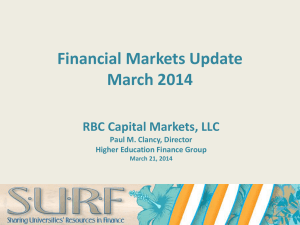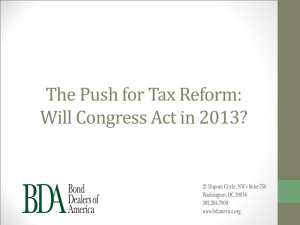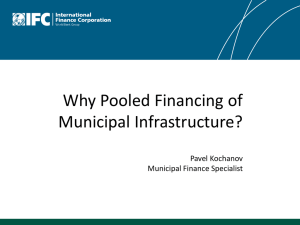Municipal Bond Market Update & A Look Ahead
advertisement

Municipal Bond Market Update & A Look Ahead April 29, 2014 Florida Government Finance Officers Association Webinar Introduction Jay Glover Managing Director David Moore Managing Director Public Financial Management, Inc. 300 S. Orange Avenue Suite 1170 Orlando, Florida 32801 Public Financial Management, Inc. 300 S. Orange Avenue Suite 1170 Orlando, Florida 32801 407-406-5760 direct line 407-648-2208 main line 407-648-1323 Fax gloverj@pfm.com 407-406-5751 direct line 407-648-2208 main line 407-648-1323 Fax moored@pfm.com 2 Table of Contents I. Current Municipal Market II. Financing Trends III. Rating and Credit Considerations IV. Post Issuance Compliance V. Municipal Advisors 3 Current Municipal Market Municipal Market Update • • • Municipal market volume Composition of the municipal market Interest rate movement in 2013 – – • Supply Demand Credit spreads Looking Ahead 5 2013 Market Rate Movement • • • The rise in rates was significant on the long end of the curve during 2013, rising by 105bps and 136bps in the 10 year “AAA” MMD and 30 year “AAA” MMD rates, respectively, however since the start of 2014 rates have improved by 52bps and 68bps This upward trend in rates started in May and gained momentum in late June when Federal Reserve Chairman Bernanke indicated that reduced “downside risks to growth” could allow the Fed to slow the pace of its bond buying efforts The municipal market was particularly hard hit as these comments came during a prolonged period of bond fund outflows that coincided with the negative sentiment caused by Detroit’s bankruptcy filing and Puerto Rico’s budget difficulties Early 2013 to Early 2014 AAA MMD Rate Movement 4.50% + 300 4.00% + 255 + 210 3.00% + 165 2.50% 2.00% + 120 80 83 84 84 83 82 81 79 78 78 79 80 80 80 74 76 78 66 70 65 65 63 59 59 62 1.50% 1.00% (Increase in Basis Points) 3.50% Change in MMD (since 1/15/2013) 1/15/2013 MMD 4/15/2013 MMD 7/15/2013 MMD 10/15/2013 MMD 4/21/2014 MMD + 75 41 31 + 30 16 0.50% 2 0.00% 5 1 - 15 2 Source: Bloomberg & TM3 3 4 5 6 7 8 9 10 11 12 13 14 15 16 17 18 19 20 21 22 23 24 25 26 27 28 29 30 6 Municipal Market Volume • Municipal market volume decrease in 2013 as refunding volume declined starting in April – Total issuance in 2013 fell by $50B to $331B which is down ≈15% versus 2012 issuance Decade of Municipal Bond Finance 500 450 Amount ($ Billions) 400 76 350 300 95 92 131 80 28 109 42 56 55 62 51 25 250 79 88 98 86 156 73 200 150 100 238 263 229 221 258 274 110 93 261 51 75 61 151 145 160 2011 2012 2013 280 208 50 0 2002 2003 2004 2005 2006 New Money Source: Bond Buyer 2007 2008 Combined 2009 2010 Refunding 7 Demand – Mass Exodus from Munis in 2013 2009-2014 Monthly Mutual Fund Inflows (Outflows) • $10 $5 Billions $0 • ($5) Consecutively since April 1st, the municipal market has seen $67 billion flow out of mutual funds In 2013, bond funds were positive for only 11 weeks ($10) ($15) • 6/1/10 12/1/10 6/1/11 12/1/11 6/1/12 12/1/12 6/1/13 12/1/13 Since the beginning of 2009, the municipal market has seen wild swings in fund flows. After four years, total fund flows are near a net wash Cumulative Inflows (Outflows) since 2012 $70 $56 $60 $50 $59 $59 $57 $58 $49 $41 $40 Billions ($20) 12/1/09 $31 $30 $20 $20 $13 $10 $7 $3 ($7) ($7) $0 ($10) Source: Bloomberg & TM3 01/2014 12/2013 11/2013 10/2013 09/2013 08/2013 07/2013 06/2013 05/2013 04/2013 03/2013 02/2013 01/2013 12/2012 ($20) 8 Recent Market Rate Movement • • Low supply has helped keep rates in check Fund flows have turned from negative to slightly positive renewing demand 4.50% + 20 12 4.00% 9 + 10 2 3.50% 2 6 - 10 11 2.50% - 20 24 2.00% - 30 34 1.50% - 40 40 - 50 48 48 48 49 Change in MMD (since 12/20) Source: TM3 12/20/2013 MMD 2044 2043 2042 2041 2040 2039 2038 2037 2036 2035 2034 2033 55 55 55 55 55 56 57 57 58 59 60 61 62 62 62 2032 2029 2028 2027 2026 2025 2024 2023 2022 2021 2020 2019 2018 2017 2016 0.00% 2015 0.50% 2031 52 2030 45 1.00% (Increase in Basis Points) 3.00% - 60 - 70 4/21/2014 MMD 9 Municipal Market Composition Pre-Crisis Post-Monolines Now 2007 2010 2013 Municipal Bond Issuance Municipal Bond Issuance Municipal Bond Issuance % of Total Par by Rating Category % of Total Par by Rating Category % of Total Par by Rating Category Insured all Categories All B-Rated 7.0% Categories 4.9% Triple A-Rated Categories 0.2% Triple A-Rated Categories 15.0% All Double ARated Categories 21.6% All Single ARated Categories 6.1% 2007 Insured all Categories 66.2% All B-Rated Categories 5.9% In 2007, 2/3s of the market was insured; just 0.2% of all issuances were natural triple-As. Nearly 90% was of all issuances were double-A rated or better Source: Bloomberg & TM3 All Single ARated Categories 22.5% 2010 All Double ARated Categories 50.6% In 2010, insured issuance dropped to 7%, natural triple-A issuance increase to 15%. And, double-A rated or better issuance fell to 65% All B-Rated Categories 2% Insured all Categories 6% All Single ARated Categories 27% Triple A-Rated Categories 14% 2013 All Double ARated Categories 51% Issuance breakdowns in 2013 remained similar to that from 2010, with issuances of lower credits falling slightly, however the market has now adjusted to a vastly more complicated credit landscape 10 Credit Spread Volatility Persists • • Low yields on high-grades continue to push investors out the credit curve in search of yield However, due to large fund liquidations beginning in April, credit spreads saw upward pressure for the second half of 2013 Revenue Credit Spread Movement (since November 2011) 250 Aa/AA A/A Baa/BBB Basis Points 200 150 133 100 70 50 20 0 Source: TM3 11 Headline Risk Creates Market Challenges • Fear of bankruptcy and defaults creates market volatility that impacts all local government credits Lehman Brothers files for Bankruptcy Detroit files for Bankruptcy 6.0 5.5 1.3 5.0 0.3 Feb-08 Feb-09 Feb-10 Feb-11 Feb-12 Jan-13 Jan-14 4.5 (0.8) 4.0 (1.8) MMD Yield (%) Municipal Bond Fund Flows ($ Billions) 2.3 3.5 (2.8) 3.0 (3.8) Meredith Whitney predicts “a spate of municipal defaults” 2.5 (4.8) 2.0 Inflows Source: Bloomberg & TM3 Outflows 30 Year MMD 12 Municipal Bankruptcies • Many of the largest municipal bankruptcies in history have occurred in the past few years Largest Municipal Bankruptcies In U.S. History Issuer Year Debt Detroit, MI 2013 $18 billion Jefferson County, AL 2011 $4 billion Orange County, CA 1994 $2 billion Stockton, CA 2012 $1 billion San Bernardino County, CA 2012 $500 million 13 Current Municipal Market Rates in Perspective MMD AAA G.O. Curve 5.0% • 4.0% Current rates are towards the middle of the range seen over the past five years Yield 3.0% 2.0% 12/31/2009 12/31/2010 12/31/2011 1.0% 12/31/2012 12/31/2013 4/21/2014 0.0% 1 2 3 4 5 6 7 8 9 10 11 12 13 14 15 16 17 18 19 20 21 22 23 24 25 26 27 28 29 30 Maturity Bond Buyer 20-Year GO Index 14.0% 13.28 • • In a broader historical context, rates still look very attractive Inflation will always be the biggest determinant of absolute levels 12.0% 10.0% 8.0% 6.0% 5.29 4.32 4.0% 3.29 2.0% Source: Bloomberg & TM3 14 Looking Ahead • In 2014, attention will be on fund flows, headline events, regulatory concerns and Fed policy • Fund outflows and their negative impact on liquidity continue to present challenges. Hopefully, fund flows stabilize or turn positive in early 2014 • Eyes will be on Puerto Rico, as well as Detroit – • Regulatory environment – • Market participants will continue working through the impacts of the SEC Municipal Advisory rules, the Volcker Rule and Basel III, as well as the IRS’s proposed changes to the determination of the new issue price Federal Reserve – • There has been much debate and media discussion surrounding Puerto Rico’s finances and credit ratings. With more the 75% of U.S. municipal mutual funds owning Puerto Rico debt, any event associated with Puerto Rico and its ≈$70 billion of outstanding debt will certainly impact the broader municipal market Attention will be on Fed Chairwoman Janet Yellen. Fed policy focus is likely to shift from QE tapering to the Fed Funds target rate. 2013 saw long-term rates spike in anticipation of Fed tapering. If the Fed sees enough positive economic news in 2014, the Fed Funds target rate could rise with municipal rates following the lead of short-term Treasury rates. The municipal curve could flatten. Consensus wisdom from the market prognosticators is for municipal market supply to remain flat to slightly down from 2013 15 Commercial Banks Continue to Play in 2014 • Multiple factors have driven commercial banks to play an active role in the municipal market Evolution of Bank Credit Ratings in the Last Decade Ratings April 2001 Aaa Bank of America Wells Fargo Bank Credit Agricole UBS Aa1 Aa2 Aa3 A1 Bank of New York Mellon Barclays Bank BBVA Citibank HSBC Bank Banco Santander BNP Paribas BPCE (Banque Populaire) ING Bank JP Morgan Chase Bank Royal Bank of Scotland State Street Bank & Trust Deutsche Bank Societe Generale UniCredit Bank of China BTMU Standard Chartered Standard Chartered Baa2 Baa3 January 2014 Royal Bank of Scotland UBS Wells Fargo Bank Deutsche Bank HSBC Bank ING Bank Nordea Bank Societe Generale State Street Bank & Trust SMBC UniCredit Goldman Sachs Bank Morgan Stanley Credit Suisse A2 A3 Baa1 July 2007 Bank of America Bank of New York Mellon Citibank JP Morgan Chase Bank Banco Santander Barclays Bank BBVA BNP Paribas Credit Agricole Credit Suisse BPCE (Banque Populaire) BTMU Mizuho Corporate Bank Bank of New York Mellon BTMU HSBC Bank JP Morgan Chase Bank Nordea Bank Bank of China Credit Suisse Barclays Bank BNP Paribas BPCE (Banque Populaire) Credit Agricole Deutsche Bank State Street Bank & Trust SMBC Wells Fargo Bank Mizuho Corporate Bank Standard Chartered Goldman Sachs Bank ING Bank Societe Generale UBS Citibank SMBC Mizuho Corporate Bank Bank of China Royal Bank of Scotland Banco Santander Morgan Stanley Bank of America UniCredit BBVA 16 Commercial Banks Continue to Play in 2014 • Role of banks in municipal finance – Traditional role • – Current role • • – Bank qualified (less than $10 million) and short financings Larger & longer financings – 15 to 20 years for some banks – Par amounts over $100 million for some institutions Replace letter of credit backed VRDOs with direct placement bank variable rate obligations Factors to consider • • • • All bank proposals are NOT created equal Call provisions “Make whole” language is rarely “make whole” Terms and conditions » Increased costs » Rating downgrade triggers » Term out in the event of a default 17 Financing Trends What Types Of Bonds Are There? • Municipal Bonds, also called “munis,” are debt securities issued by states, cities, counties and other government entities − General Obligation Bonds are bonds backed by the full faith and credit of the issuer, which has the power to tax residents to pay bondholders − Revenue Bonds are bonds that are backed by revenues from a specific project or source, such as highway tolls, utility revenues, hospital revenues, sales tax, etc. − Certificates of Participation are secured by annual lease payments (subject to annual appropriation) derived from a specific revenue source, basket of revenues, or any other available revenues − Conduit Bonds are issued by governments on behalf of private entities such as non-profit colleges or hospitals -- these “conduit” borrowers agree to repay the issuer who in turn pays the interest and principal on the bonds – if the conduit borrower fails to make a payment, the issuer usually is not required to pay the bondholders 19 Tax Status Of Municipal Bonds • Tax-Exempt Bonds − The interest earnings on most municipal bonds (depending on purpose of financing) generally is exempt from federal tax and also may be exempt from state and local taxes for residents in the states where the bond is issued, making them an important investment vehicle for institutions and high net worth individuals − Issuance must be authorized by a governing body and proceeds must be used for state and local government purposes − Subject to arbitrage rebate and advance refunding restrictions − Interest rate based off tax-exempt MMD scale • Taxable Bonds − A fixed-income security issued by a government or related agencies, the income from which is not exempt from taxation − Generally issued to finance a project or activity that does not provide a major benefit to the public -- in such cases, the federal government will not permit tax-exemption − Not subject to arbitrage rebate (can invest proceeds at a profit) or advance refunding restrictions − Interest rate based off taxable U.S. Treasuries • Alternative Minimum Tax (AMT) Bonds − The AMT is designed to prevent taxpayers from escaping their fair share of tax liability through various tax breaks − Depending on their purpose, some municipal bonds can be exempt from federal taxes, but still be subject to AMT − Interest rate based off tax-exempt MMD scale 20 Why Issue Taxable Municipal Bonds? 1. Because You Have To • Project or activity does not provide a major benefit to the public (private activity bonds) – Parking garage at an airport that is used by rental car companies – Pension obligation bonds – Some sports facility projects – Pre-event financings for catastrophe related issuers – Advance refunding of bonds that cannot be advance refunded with tax-exempt debt 2. Because You Want To • Provides issuer more operational flexibility • Provides issuer a larger investment base • Provides issuer with a better interest rate than tax-exempt bonds – Build America Bonds (portion of interest is subsidized by federal government) – Tax Credit Bonds (issuers receive tax credit on their federal tax returns) 21 Interest Rate Mode • Fixed Rate Debt − Interest rate is fixed through the final term of the loan at time of pricing − Most municipal fixed rate debt is structured with semi-annual interest payments and annual principal payments − Traditionally associated with long-term debt but is also available for interim and short-term debt − Bonds, COPs, state revolving loans/programs, bank loans, notes • Variable Rate Debt − Interest rate resets weekly, bi-weekly, monthly or yearly based on an index or open market pricing − Commonly structured with monthly interest payments and yearly or semi-annually principal payments − Depending on type of debt, may require issuer to secure external liquidity (letter of credit) − Variable Rate Demand Obligations (VRDO), SIFMA/LIBOR Floating Rate Notes, Auction Rate Securities (ARS) , bank loans • Synthetic Fixed or Variable Rate Debt − Interest rate mode of underlying debt can be changed via a separate interest rate hedge agreement − Debt issued in variable rate mode can be converted to fixed rate mode and vice-versa − Requires a higher level of sophistication and understanding than traditional fixed or variable rate debt − Mark-to-market (MTM) can result in substantial penalties to terminate the contract voluntarily or involuntarily 22 How Can We Finance This Project? • A City Manager is directed by his/her City Council to build a new municipal complex comprised of a city hall, fire station and various recreational facilities • The City Manager approaches you, the Finance Director, asking how the City can best finance this project? • Factors to consider / Questions to ask: − What is the estimated cost of the project? How quickly are the funds needed? − Can the City afford to pay the debt from existing revenues or will it require a new revenue source? − If it requires a new revenue source, does the City Council have the legal authority to impose a new fee/tax or increase an existing fee/tax? If not, is the City Council willing to put a measure on the ballot? Will it pass? − If the funds are coming from existing revenues, how much can the City afford and does the City have legal authority per state law and city charter to pledge a certain revenue(s) to secure debt? − How much of this potentially pledged revenue does the City collect annually? Is it fairly stable? Can this revenue source be taken away by the state or county at any time in the future? − What is the most efficient financing structure given these parameters? 23 How Can We Finance This Project? • A County Administrator is directed by his/her County Commission to their community, which result in the building of a new stadium and practice fields • The project is estimated to cost $50 million and the minor league baseball team would like to lease the stadium from the County for 25 years at $1.5 million per year • Factors to consider / Questions to ask: − Since the $1.5 million lease payments will not cover principal and interest, how can the County minimize its financial exposure? − Does the project qualify for tax-exemption? How much private money (naming rights, parking operators, other events) is expected to be generated from the project and does that affect its tax-status? Are there any state grants available? − Other than County funds, what other revenues might be available to secure the debt? Special assessments, tax increment revenues, tourist development tax (hotel bed tax) revenues? − What is the most efficient financing structure given these parameters? 24 Publically Offered Bonds • Very efficient for longer term transactions – 30 years (rates fixed for entire term) • Can accommodate innovative and creative financial solutions beneficial to the issuer • Highest cost of issuance • Debt rating and/or credit enhancement (bond insurance) may be required. Less so in today’s market versus pre-credit crisis. • Funding of Debt Service Reserve Fund required for most credits (General Obligation Bonds are the exception). • Risk of future changes in tax laws passed in investors (i.e., no “gross up” language) • Sold either competitively or negotiated • Initial disclosure requirements (official statement) can be burdensome • Continuing disclosure required after bonds are sold • Flexible call features (10 year par call is standard) 25 Privately Placed Bank Loans • Does not require that transaction be rated or insured • No offering documents or registration required • Banks usually do not require a Debt Service Reserve Fund • Disclosure usually limited to receipt of CAFR and budget (no official statement) • Minimal cost of issuance • The purchase of tax-exempt loans by non-bank subsidiaries and affiliates of commercial banks debt has resulted in more efficient “nonbank qualified” pricing 26 Privately Placed Bank Loans • Risk of future tax law changes retained by the issuer. Bank loans usually contain interest rate “gross up” language; providing the bank the right to increase the loan rate should tax law changes negatively impact the bank’s after tax yield • Term limited to 20 years and some banks will not provide a fixed rate for the entire term. Instead, the bank would have a “put” option during the term of the loan (5 , 10, or 15 years). This gives the bank the option to “put” the loan back to the issuer and force them to refinance at the then current market rates. • Level of municipal finance expertise varies. Larger banks have dedicated professionals; while smaller institutions may not. 27 Commercial Paper • Small to Medium Project Cost • Ability to Drawdown Proceeds over time to fund Project • Desired Repayment is short (5 years or less) and repayment timing is flexible • Interest rate is variable • Letter of Credit (LOC) may be required from bank, which is costly in current market (up to 100+ basis points). Also leaves issuer exposed to credit risk of the bank as well as renewal risk on LOC. • Early Prepayment Flexibility • Bridge/Interim Financing 28 SRF Loan • State Revolving Fund Loans (SRF) are limited to water and sewer type projects. • State of Florida issues bonds to generate a pool of funds, which are then used to make loans to local governments. • Issuer must complete application about projects to be financed, which is then reviewed by the State. Assuming the projects qualify and funds are available then all or a portion of the project may receive SRF funding. 29 SRF Loan • Interest rates are generally lower than what is available through public bond market or private bank market because interest rates are subsidized by the State (2.00% to 3.00%). • The term of these loans is 20 years with debt service paid on a level annual basis. As a result, the issuer has little structuring flexibility. • Revenue pledged as security typically subordinate to other water and sewer debt of the issuer (very important to make sure SRF documents comply with existing water and sewer bond documents to the extent issuer has other debt). • Funds are generally provided on a reimbursement basis so some type of interim financing or internal financing may be required. • Limited amount of capacity and typically abundant demand. • Stringent ongoing reporting/compliance requirements (a lot of paperwork). 30 Summary of Options Type of Financing Pros Cons Publicly Offered Bond • Able to reach a broad market of investors • Can issue bonds out to 30-years • Flexible schedule • Need ratings or credit enhancement • Higher costs of issuance • Greater administrative requirements Privately Placed Bank Loan • Does not require ratings or credit enhancement • Lowest rates available if structured to enable banks to receive tax advantage (Bank Qualified rates) • Minimal cost of issuance • Fewer administrative requirements (continuing disclosure) • Typically longest allowable term is 15-20 years • Interest rate subject to increase if tax laws change Commercial Paper • Generally low interest rates (short term) • Flexible repayment schedule • Early prepayment allowed • Interest rate is variable • Requires letter of credit, which can be costly (credit risk) State Revolving Fund Loan Program • Interest rates are usually lower than what is available to smaller local governments • The SRF takes care of sale process and arbitrage compliance • Potential for principal forgiveness through legislative appropriation • Typically subordinate pledge of revenues • Stringent application process • Specific coverage requirements • Term limited to 20 years with level debt service • Loans are disbursed on a cost incurred basis, not upfront (reimbursement) • Limited amount of capacity available 31 Ratings and Credit Considerations Bond Ratings • What is a Bond Rating? – Measure of risk to bondholders – Reflects issuer’s ability & willingness to repay debt on time and in full (who, how, what?) – Factors in expected loss and recovery – Denotes credit quality by rating level – Independent opinion (subjective process) – Forward looking projection 33 Bond Ratings • Bond Rating is Not – – – – – – Audit Recommendation to buy, sell or hold a security Static or permanent Opinion of community’s quality of life Performance evaluation of current political leadership Judgment of quality of service delivery 34 Rating Scale Highest Rating Below Investment Grade S&P Fitch Moody’s AAA AAA Aaa AA+ AA+ Aa1 AA AA Aa2 AA- AA- Aa3 A+ A+ A1 A A A2 A- A- A3 BBB+ BBB+ Baa1 BBB BBB Baa2 BBB- BBB- Baa3 BB BB Ba B B B C C C 35 Changes in Rating Criteria • • Changes in Moody’s Rating Methodology for Local Government General Obligation Debt Factor 1 Economy/Tax Base Factor 2 Finances Factor 3 Management Factor 4 Debt/Pensions 30% 30% 20% 20% Was 40% Unchanged Unchanged Was 10% Rationale for change in weightings: – – Factor 1 weighting lowered to reduce the influence of tax base size Factor 4 weighting increased to include a specific quantitative measure for pensions Source: Moody’s Investor Services 36 36 Moody’s Outlook Revised to STABLE STABLE States Local Governments Stabilizing national economy supports growth in state revenues and reserves. “The New Stable” reigns as the era of constrained resources persists but the worst is over. STABLE US Public Power Utilities’ unregulated ability to establish electric rates to meet sound debt service coverage rations drives our stable outlook Source: Moody’s Investor Services 2014 Outlook: US Public Finance NEGATIVE NEGATIVE STABLE Not-for-Profit Hospitals State Housing Finance Agencies (K-12 STABLE) Higher Education Not-for-Profits K-12 Schools Expense growth to outpace revenue growth for all sectors except Independent K-12 Schools. Revenue growth will decline; margins will contract on new investments. STABLE US Airports Slight growth in enplanements, or the number of seats sold on a flight, drives our stable outlook State HFAs have evolved to meet the demands of the new lending environment. Revised to STABLE US Toll Roads Traffic growth is set to rise about 1.5%, marking a sustainable comeback from recession lows 37 Moody’s Outlook – Local Governments Source: Moody’s Investor Services 2014 Outlook: US Public Finance 38 Additional Rating Information • Standard & Poor’s “Detroit’s Bankruptcy Filing is Becoming a Long and Costly Row to Hoe” – • Standard & Poor’s does not View Detroit’s Chapter 9 Filing as the Start of a New Trend – • https://www.globalcreditportal.com/ratingsdirect/renderArticle.do?articleId=1165511&SctArtId=170485 &from=CM&nsl_code=LIME Standard & Poor’s “An Aging Population Puts Pension Plans to the Test” – • https://www.globalcreditportal.com/ratingsdirect/renderArticle.do?articleId=1223365&SctArtId=19980 5&from=CM&nsl_code=LIME https://ratings.standardandpoors.com/us-public-finance/An-Aging-Population-Puts-Pension-Plans-ToThe-Test.html Articles available upon request – Fitch Local Government Tax-Supported Rating Criteria • – Moody’s Adjustments to State and Local Government Reported Pension Data • – Released: April 2013 Standard & Poor’s: Bank Loans And Bond Ratings: What to Disclose? • – Released: August 2012 Released: June 2013 Standard & Poor’s: US Local Governments General Obligation Ratings Methodology and Assumptions • Released: September 2013 39 Bond Insurance • An insurance policy purchased by the issuer at pricing that guarantees the timely payment of principal and interest on the bonds. The issuer benefits from its bonds pricing at lower interest rates that reflect the credit enhancement provider’s credit ratings – but, of course, the issuer must pay a fee for this benefit. • Prior to 2007/2008, there were seven “Aaa/AAA/AAA” rated insurance providers -- today there are none. • Insured Penetration Stabilized in 2013, after declining every year since 2005. 30% 25% 20% 15% 10% 5% 0% 2008 2009 2010 By Par Value 2011 2012 2013 By # of Transactions 40 Bond Insurance • Assured Guaranty Municipal Corp. (AGM) and Build America Mutual (BAM) are the two most prevalent bond insurers in today’s market − Assured Guaranty Municipal Corp. (AGM) is currently rated “A2” (stable) by Moody’s and “AA” (stable) by Standard & Poor’s (upgraded March 2014 by S&P from AA-) In July 2013, Assured Guaranty launched Municipal Assurance Corp. (MAC), a new municipal bond insurance company that will insure only select categories of U.S. municipal bonds − Build America Mutual (BAM) is currently rated “AA” (stable) by Standard & Poor’s • Based on the issuer’s credit rating, insurance premium and pricing benefit of the insurance, does it make sense to purchase insurance? • Does insurance need to be purchased in order to obtain a DSRF surety? If so, how much insurance? 41 Debt Service Reserve Fund • The DSRF is an amount often required to be set aside to cover one year of principal and interest payment • DSRFs are often used with revenue bonds although we have seen many essential service (water and sewer, electric, etc.) revenue bonds being done without DSRFs recently • Do the outstanding bonds have an existing DSRF? • How is this DSRF funded? Is it funded with cash, surety or letter of credit? • Are the new refunding bonds required by the authorizing documents and/or the market to have a DSRF? • If required to have a DSRF, can existing cash funded DSRF be transferred into refunding deal (usually it can) or can existing insurance/surety providers be transferred over (usually they cannot)? • If required to substitute an existing surety policy with either cash or bond proceeds due to lack of surety providers in the current market, is it economically feasible to do so? • If new bonds are not required to fund a DSRF, can existing cash funded DSRF be released 42 Post Issuance Compliance A Change In IRS Focus • • Prior focus on pre-issuance type compliance problems – Is the project financeable with tax-exempt bond proceeds? – Less focus on post-issuance compliance, such as arbitrage rebate Beginning in 2007, shift in focus to post-issuance compliance – – – – • “Soft contact” surveys sent to 501(c)(3) organizations and governmental entities to assess post-issuance compliance Significant increase in IRS audits Emphasis on written policies and procedures to manage post-issuance compliance Change in IRS Forms to include acknowledgement of written procedures (IRS 8038, IRS 990 Schedule K) Two main measurements: Arbitrage rebate and Private Business Use 44 Thoughts & Considerations • The IRS is focused on post-issuance compliance – Attempting to influence issuers to adopt and implement written post-issuance compliance procedures • • • Arbitrage rebate and yield restriction compliance is an integral part of post-issuance compliance – • Audits, “soft-contact” surveys Changes to 8038 series forms Keeping good records, making timely allocations, and proactively monitoring arbitrage rebate and yield restriction liabilities will mitigate audit risk Developing process for identifying and quantifying private use when planning for the issue and after 45 Compliance Program Considerations • • • • • • • Written policies & procedures Team to manage compliance process Arbitrage rebate & yield restriction compliance Record retention Private business use compliance Staff training and education Continuing disclosure requirements 46 Adopt Written Procedures • • Create a framework to manage and implement your compliance program IRS is strongly encouraging issuers to adopt written procedures that address: – – – – – – • • Due diligence reviews at regular intervals Identifying the person responsible for review Training of the responsible person Retention of adequate records Procedures to timely identify noncompliance Steps to timely correct noncompliance Detailed, relevant and implemented Plan, execute, review and audit 47 The New IRS Form 8038 • • IRS revised Form 8038-G in September 2011 to include lines #43 and #44 Issuers that are unable to check the boxes on the Form 8038 / 8038-G may receive greater scrutiny 48 Record Retention Requirements • Requirements are burdensome and may not be consistent with document destruction policies – – Life of the Bonds + 3 years If the Bonds are refunded, life of refunding bonds + 3 years • Consider separate document collection, storage and destruction policies for bond related records • Consider electronic storage systems 49 Examples – Records to Retain • • • • • • • • • Board minutes, resolutions Appraisals Bond transcripts Newspaper ads, misc. correspondence Investment records Expenditure histories Invoices IRS Filings Records related to acquisition of investment agreements and interest rate swaps • Payments for credit facilities • Arbitrage rebate and yield restriction compliance reports 50 Wrapping it up! • • If you have written policies and procedures – make sure you follow them! Create internal controls and processes just like other business functions – you can’t report what you didn’t identify and measure 51 Municipal Advisors Definition of Municipal Advisor • Dodd-Frank defines “municipal advisor” as a PROVIDES MUNICIPAL FINANCIAL ADVICE PERSON (Not a municipal entity or an employee of a municipal entity) Includes “Advice” Regarding the Structure, Timing, Terms, or Other Similar Matters SOLICITS BUSINESS FOR MUNICIPAL FINANCIAL PRODUCTS ON BEHALF OF UNAFFLILIATED 3rd PARTIES Source: Page 777 of the Full Rule (http://www.sec.gov/rules/final/2013/34-70462.pdf). Please note this is for informative purposes only and should not be considered legal advice. 53 Municipal Advisor Regulations • Advice – – – Construed broadly Objective determination based on all relevant factors Factors include: • • • – • Term excludes: general information “Effective Date” – – • Whether person makes a “Particularized Recommendation” Whether the content, context and manner of presentation would reasonably cause someone to take action OR refrain How individually tailored the information is to a specific OR targeted group of muni entities or obligated persons Originally: 60 Days After Federal Register Publication – January 13, 2014 Postponed until July 1, 2014 What is Effective? – – All Rules All Forms Source: Page 777 of the Full Rule (http://www.sec.gov/rules/final/2013/34-70462.pdf). Please note this is for informative purposes only and should not be considered legal advice. 54 Rule References Incentives for Using MAs • Fiduciary duty • Reduced borrowing and issuance costs • Better financing terms • Improve capital formation • Positive impact on taxpayers • Regulatory oversight over standards, training and conduct Source: Page 777 of the Full Rule (http://www.sec.gov/rules/final/2013/34-70462.pdf). Please note this is for informative purposes only and should not be considered legal advice. 55 Providing Municipal Financial Advice • What is advice under Rule 15Ba1-1(d)(1)(ii) Recommendations of municipal financial products Recommendations for the issuance of municipal securities Recommendations based on the structure, timing, and terms of municipal products or issuance of municipal securities Recommendations particularized to the specific needs, objectives, and/ or circumstances of municipal entity or obligated person Source: Page 777 of the Full Rule (http://www.sec.gov/rules/final/2013/34-70462.pdf). Please note this is for informative purposes only and should not be considered legal advice. 56 General Information Not Considered to be Advice • What is NOT advice under Rule 15Ba1-1(d)(1)(ii) Publicly held information (outside of municipal entities or obligated person) Unspecific Information (not specific to a particular municipal entity or type of municipal entity) Factual information (no assumptions/opinions/viewpoints) Educational material (instructional or explanatory info) Source: Page 777 of the Full Rule (http://www.sec.gov/rules/final/2013/34-70462.pdf). Please note this is for informative purposes only and should not be considered legal advice. 57 Rule of Thumb • If the advice can be reasonably viewed as a specific suggestion to the municipal entity to either act or refrain from acting with regard to municipal financial products or the issuance of municipal securities, then it is Advice under the Rule Source: Page 777 of the Full Rule (http://www.sec.gov/rules/final/2013/34-70462.pdf). Please note this is for informative purposes only and should not be considered legal advice. 58 Types of Advice Covered No Incidental Exemptions or Exclusions for DeMinimis Advice FINANCIAL HELP 5₵ MUNICIPAL ADVISER IS IN Source: Page 777 of the Full Rule (http://www.sec.gov/rules/final/2013/34-70462.pdf). Please note this is for informative purposes only and should not be considered legal advice. 59 Underwriter Exemptions • • Underwriters can only provide “advice” in certain defined situations Exemptions – “Underwriter exemption” • • – “RFP exemption” • – Dealer has been engaged to underwrite a specific issue, but not as part of an underwriting pool if the firms are not actively working on a specific transaction Provide advice regarding structure, timing, terms and other similar advice regarding specific issues, if they are engaged for that particular issue Responses to Request for Proposals and Requests for Qualification for a particular issue, including mini-RFPs to an underwriting pool “Independent Registered Municipal Advisor (IRMA) exemption” • Issuer has hired an independent Municipal Advisor (PFM) that is not the proposed underwriter – Independent MA is engaged to evaluate proposals from underwriters – Independent MA cannot be associated with proposed underwriter within the past two years Source: Page 777 of the Full Rule (http://www.sec.gov/rules/final/2013/34-70462.pdf). Please note this is for informative purposes only and should not be considered legal advice. 60








